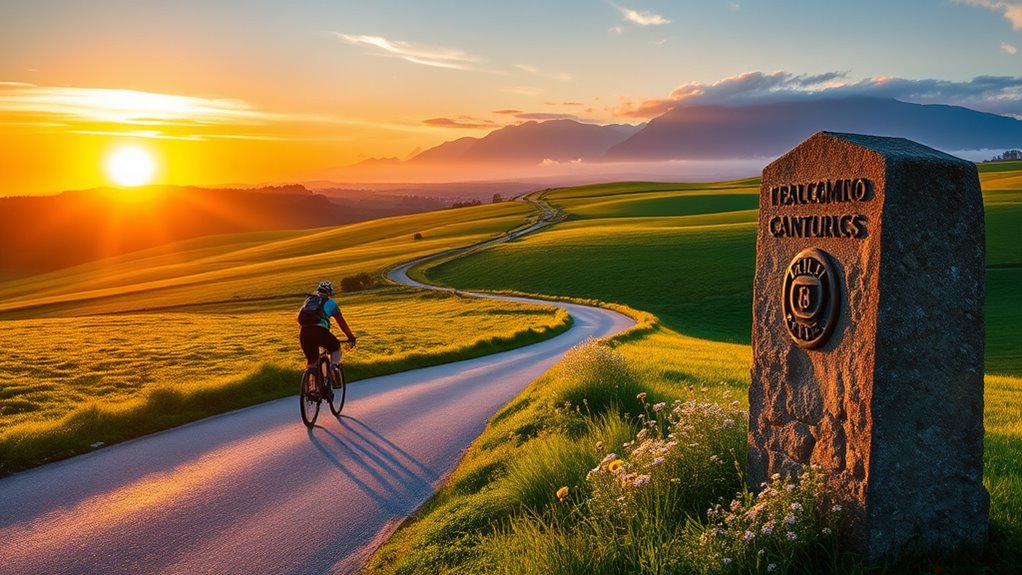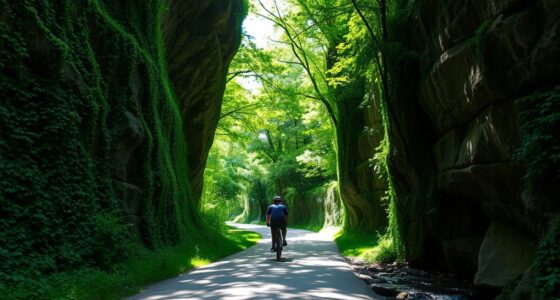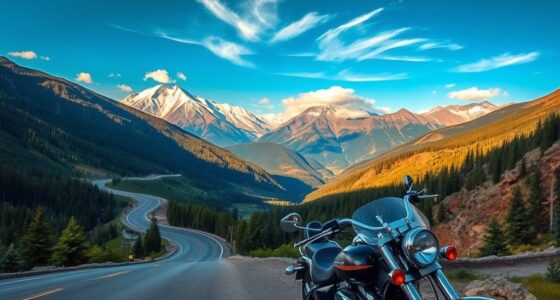Pedaling Spain’s Camino De Santiago is more than just a bike ride; it’s a transformative pilgrimage. You’ll connect with ancient traditions as you cycle through breathtaking landscapes on popular routes like the French Way or Portuguese Way. Prepare your body and bike, and plan for accommodations that cater to cyclists. Along the way, you’ll experience community, growth, and discovery that extends beyond the miles. Keep exploring to uncover more about this enriching journey!
Key Takeaways
- The Camino De Santiago offers various cycling routes, with the French Way being the most popular for its excellent infrastructure.
- Essential gear includes a mountain or hybrid bike, cycling shoes, padded shorts, and a helmet for safety and comfort.
- Accommodation ranges from basic albergues to luxury hotels, with specialized hostels providing bike storage and maintenance services.
- A Pilgrim’s Credential is required to collect stamps along the route and obtain the Compostela certificate upon completion.
- The journey fosters spiritual growth and community, allowing for deep introspection and connections with fellow pilgrims.
Overview of the Camino De Santiago
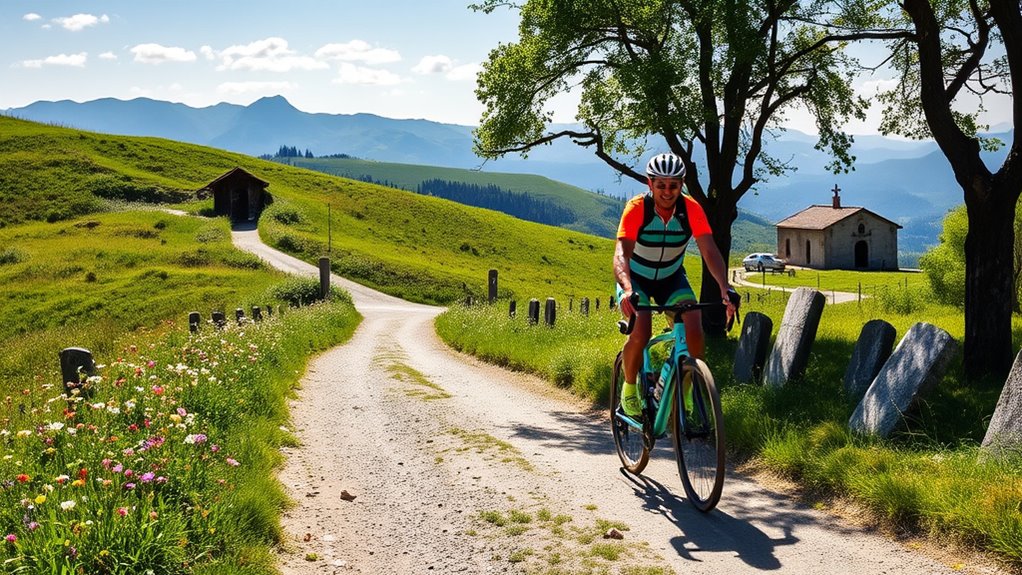
The Camino de Santiago, a historic pilgrimage route, invites you to embark on a journey steeped in spiritual significance and cultural richness.
Dating back to the 9th century, this pilgrimage gained prominence after the discovery of Saint James’ relics in 814 AD. As one of the three major Christian pilgrimages, alongside Jerusalem and Rome, it attracts over 350,000 pilgrims annually. You’ll find a variety of routes, from the French Way to the Portuguese Way, varying in distance from 71 to 621 miles. Each path is marked by yellow arrows and scallop shells, guiding you through stunning landscapes and rich cultural heritage. Multiple paths converge at Santiago de Compostela, enhancing the experience through the fusion of travelers from around the world. Many undertake this journey for self-discovery and spiritual growth, making it a deeply personal experience.
Popular Cycling Routes
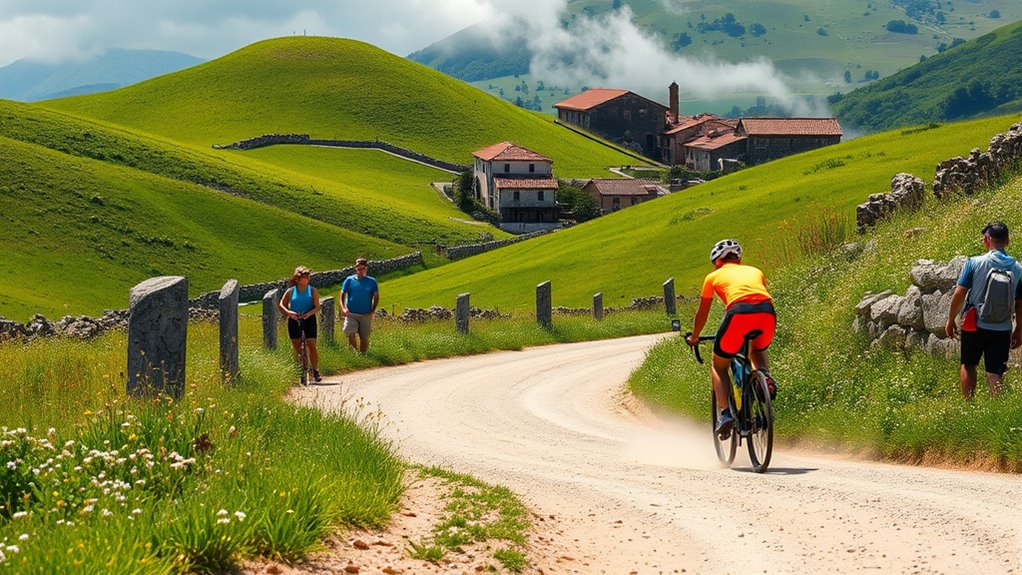
When you’re planning your cycling adventure on the Camino de Santiago, you’ll discover a variety of popular routes that cater to different skill levels and preferences.
The French Way is the most popular, boasting excellent infrastructure for cyclists. This route is best known for its popularity among pilgrims.
If you’re a beginner, the Portuguese Way offers both central and coastal routes.
For mountain bikers, the Primitive Way presents varied terrain, while the Northern Way combines stunning coastal and mountainous landscapes.
You might also consider the Interior Portuguese Way**** as a less crowded alternative.
Each route has unique challenges and experiences, so choose based on your skills and the type of bike you prefer—whether it’s a road bike, mountain bike, or hybrid bike.
Happy cycling!
Cycling Requirements and Certificates
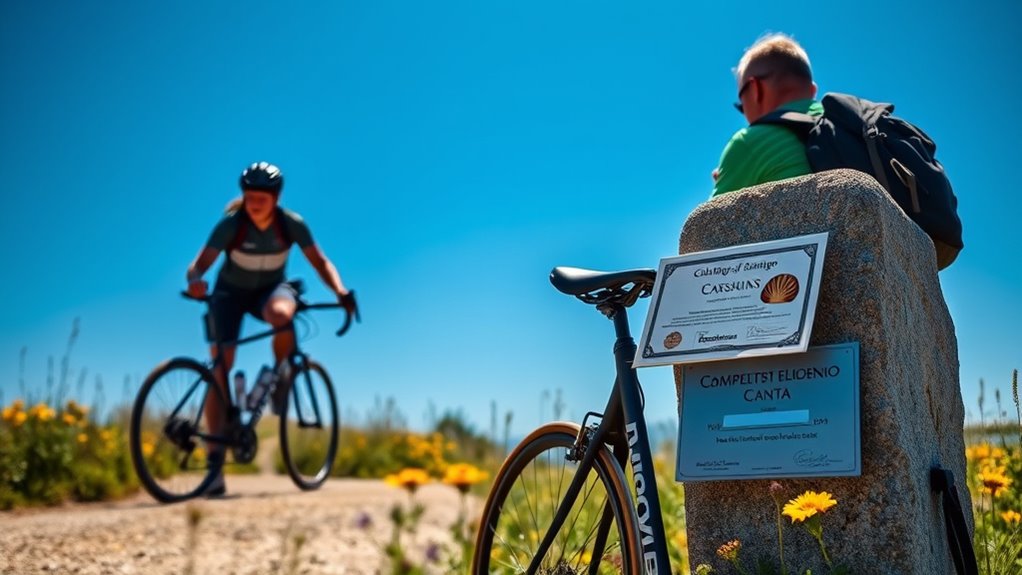
To make the most of your cycling journey on the Camino de Santiago, you’ll need to meet certain requirements and prepare adequately.
Start by engaging in physical training and terrain adaptation at least a month before your trip. Choose a mountain bike for off-road routes or a hybrid bike for mixed terrain, and don’t forget essential safety gear like helmets and comfortable cycling shoes. Additionally, cycling the Camino allows you to cover more kilometers in less time than walking, enhancing your overall experience of the pilgrimage.
Engage in physical training, choose the right bike, and prioritize safety gear for your Camino cycling adventure.
You’ll also need a Pilgrim’s Credential to collect stamps along the route, which is crucial for obtaining the Compostela certificate after completing the last 200 km.
Ensure your bike is in perfect condition, check maintenance, and consider lightweight luggage. With these preparations, you’ll be set for an unforgettable journey.
Accommodation and Logistics
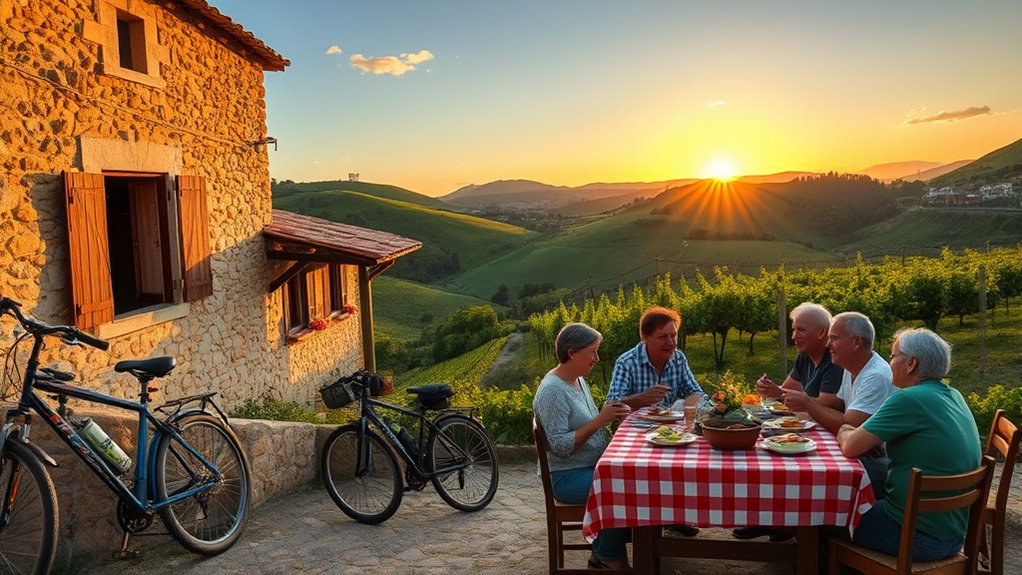
After gearing up for your cycling adventure on the Camino de Santiago, securing comfortable and convenient accommodations becomes important.
You’ll find various options, from basic albergues with shared facilities to family-run guesthouses offering personalized service. For a touch of luxury, consider paradores or 3 to 5-star hotels.
Specialized BICIGRINO hostels cater specifically to cyclists, providing secure bike storage and maintenance services. Special treatment is also offered to meet the unique needs of cyclists during their stay. It’s wise to book in advance, especially during peak seasons, while public albergues operate on a first-come basis.
Don’t forget logistics like bike rental and roadside assistance; some accommodations even offer repair stations. With thoughtful planning, you’ll ensure a smooth and enjoyable journey along this historic route.
Cultural and Historical Significance

As you embark on the Camino de Santiago, you’ll discover its profound cultural and historical significance that transcends time and borders.
This pilgrimage unites people from diverse backgrounds, fostering a vibrant sense of community. Over the centuries, it’s blended traditions and stories, shaping art and architecture across Europe. The historical discovery of Saint James’ relics in the 9th century made Santiago a major pilgrimage destination, further enhancing its allure. Engaging with biodiversity hotspots along the route can enrich your experience and highlight the importance of preserving these unique ecosystems.
Dating back nearly two millennia, the Camino began with the discovery of Saint James’ tomb in the 9th century, reaching its peak during the Middle Ages. The construction of the grand Santiago de Compostela Cathedral further solidified its importance.
Today, recognized as a UNESCO World Heritage Site, the Camino remains a testament to spiritual journeys and cultural exchange, inviting you to be part of its rich legacy.
Cycling Tips and Preparations
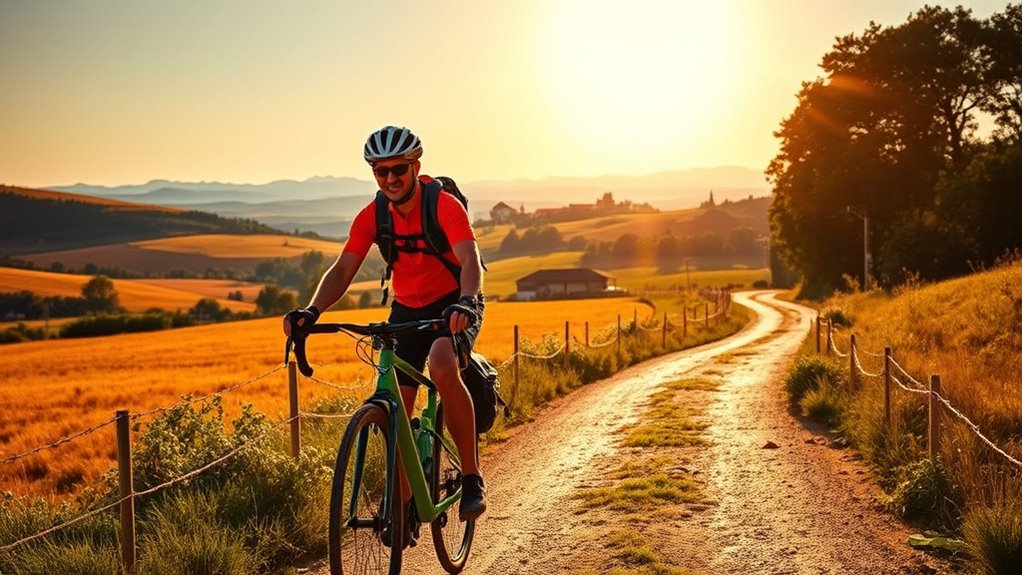
While preparing for the Camino de Santiago, it’s essential to focus on both physical and logistical readiness. Start by gradually building your endurance through consistent training, as long cycling days can be challenging. Choose a route that suits your terrain preference and time constraints. Make sure your bike is correctly adjusted for a comfortable fit, and familiarize yourself with the varied terrain, including off-road sections. Additionally, ensure you have a proper bike fit to minimize struggles during the Camino. Keep an eye on weather conditions, especially in summer or winter. Learning about local traffic laws can enhance your safety while cycling in Spain. Learn basic repair skills for punctures and carry a well-equipped tool kit. Regularly check your bike’s brakes, gears, and tires to ensure safety. Lastly, know the local traffic laws and always wear a helmet while cycling in Spain.
Essential Gear for Your Journey
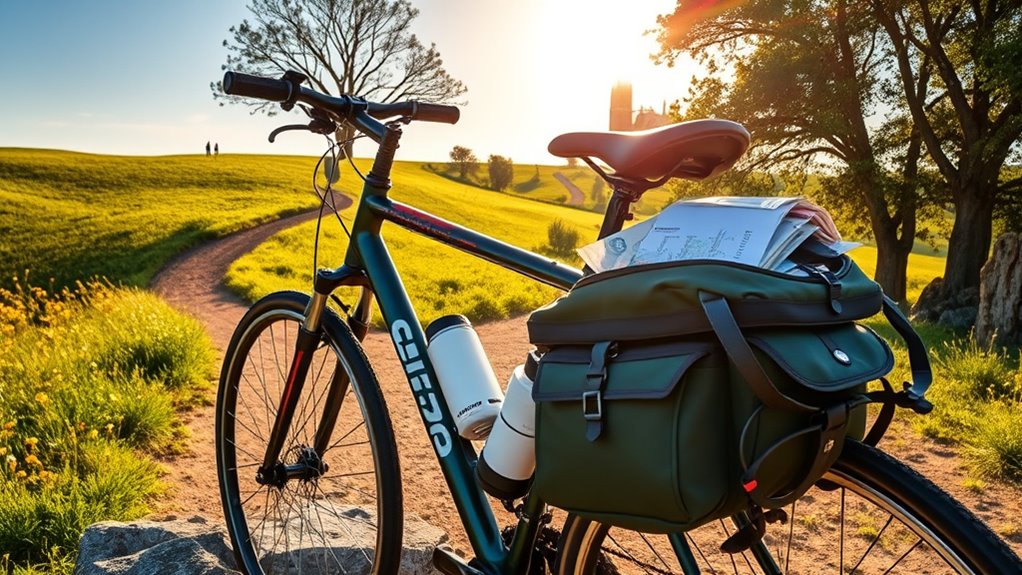
Preparing for your cycling adventure on the Camino de Santiago means equipping yourself with the right gear to ensure a smooth and enjoyable journey. Start with cycling shoes for efficient power transfer and consider padded cycling shorts for comfort on long rides. A sturdy bike helmet is crucial for safety, while a pannier rack and bag will help you carry essentials. Proper cycling equipment enhances your overall experience and can make a significant difference during the pilgrimage. Additionally, ensuring you have adequate battery life on any electronic devices will help maintain your navigation and communication during the trip. Don’t forget a bike repair kit for any unexpected maintenance needs. Pack weather-appropriate clothing like long-sleeved shirts and rain gear, along with sunglasses for eye protection. A buff or bandana, sun lotion, and a first aid kit are also wise additions. Finally, stay hydrated with a water bottle holder to make your pilgrimage more enjoyable.
Navigating the Route
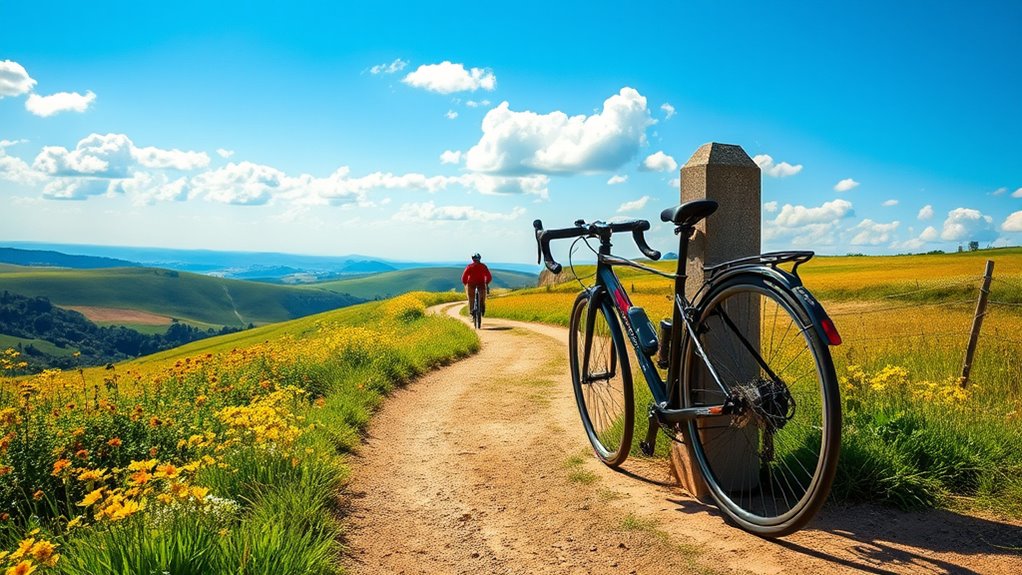
Navigating the Camino de Santiago can be an enriching experience, especially with the variety of routes available. You can choose from popular paths like the Camino Francés or the challenging Camino del Norte. Each route presents unique landscapes, from coastal views to mountainous terrains, and varies in length, with options ranging from 800 km to 1000 km. Fortunately, the Camino is well-marked with yellow arrows and scallop shells, so you won’t get lost easily. Be prepared for different terrains, including paved roads and dirt paths, which require adaptable cycling skills. Additionally, many cyclists incorporate the Camino into longer European tours, enhancing their overall adventure. Some sections offer bike-specific detours for smoother riding. Take your time to explore the cultural experiences along the way, enhancing your journey even further.
Embracing the Pilgrimage Experience
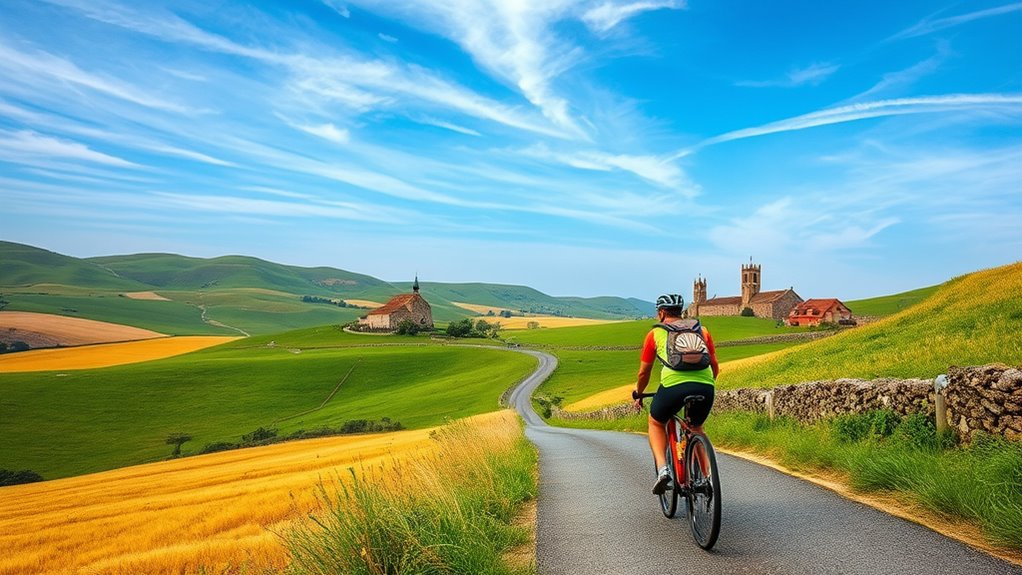
As you embark on the Camino de Santiago, you’ll find that the journey transcends physical travel, becoming a profound pilgrimage that invites introspection and spiritual growth. You’ll reflect on your life, seeking renewal or honoring someone special. Each pedal stroke brings a deeper understanding of yourself and the world around you. Visiting historic churches and cathedrals enriches your spiritual experience, often rekindling your faith or personal beliefs. Along the route, you’ll connect with fellow pilgrims, forming lasting bonds within a supportive community, reminiscent of the sense of community fostered among other walkers. The challenges of varied terrain push you physically, fostering resilience. Ultimately, this transformative journey allows you to leave behind emotional burdens, paving the way for self-discovery and a renewed sense of purpose.
Frequently Asked Questions
What Is the Best Time of Year to Cycle the Camino?
The best time of year to cycle is during spring and autumn, when temperatures are moderate and crowds are thinner.
From April to October, you’ll find pleasant weather and full services along your route. June stands out as ideal, offering warm temperatures and fewer tourists.
Just be prepared for unpredictable weather, especially in spring and early autumn, as you might encounter occasional rain and cooler mornings.
Are There Any Age Restrictions for Cyclists on the Camino?
There aren’t strict age restrictions for cyclists on the Camino, but you must be aware that the Compostela is only granted to those over 9 years old.
While there’s no maximum age limit, it’s essential to assess your physical condition.
If you’re planning to cycle, having prior experience and good bike handling skills is crucial to navigate the varied terrain.
Make sure you choose the right route that matches your ability.
Can I Bring My Dog While Cycling the Camino?
Yes, you can bring your dog while cycling the Camino! Just make sure to choose a dog-friendly route, like the French or Portuguese Way, and book accommodations in advance.
Train your dog for the journey, as they’ll need to handle long distances and varying terrains. Always keep them on a leash in crowded areas and monitor their health closely.
With proper preparation, you and your furry companion can have an unforgettable adventure together!
What Are the Common Health Issues Cyclists Face on the Camino?
When cycling long distances, you might face several health issues.
Muscle fatigue can set in, particularly in your legs and back. You could experience joint pain or overexertion if you push yourself too hard.
Falls on uneven surfaces can lead to injuries, while dehydration and heat stroke are risks in hot weather.
Additionally, prolonged sun exposure can cause skin damage.
It’s essential to stay hydrated and take breaks to minimize these risks.
Are There Guided Cycling Tours Available for the Camino?
Yes, there are guided cycling tours available for the Camino.
Companies like Experience Plus and RAW Travel provide options that cater to various skill levels and preferences. You can choose from different routes, including the Camino Frances and Camino Portugues, and enjoy features like luggage transfers and cultural experiences.
Whether you prefer an e-bike or a hybrid, these tours offer everything you need for an unforgettable cycling adventure along this historic pilgrimage.
Conclusion
As you pedal along Spain’s Camino de Santiago, you’re not just cycling; you’re embracing a journey rich in history and culture. Each turn brings new landscapes and experiences, making every moment memorable. Remember to prepare well, respect the traditions, and take the time to soak it all in. Whether you’re seeking adventure, reflection, or connection, this pilgrimage offers it all. So hop on your bike, and let the Camino guide you on an unforgettable journey!
